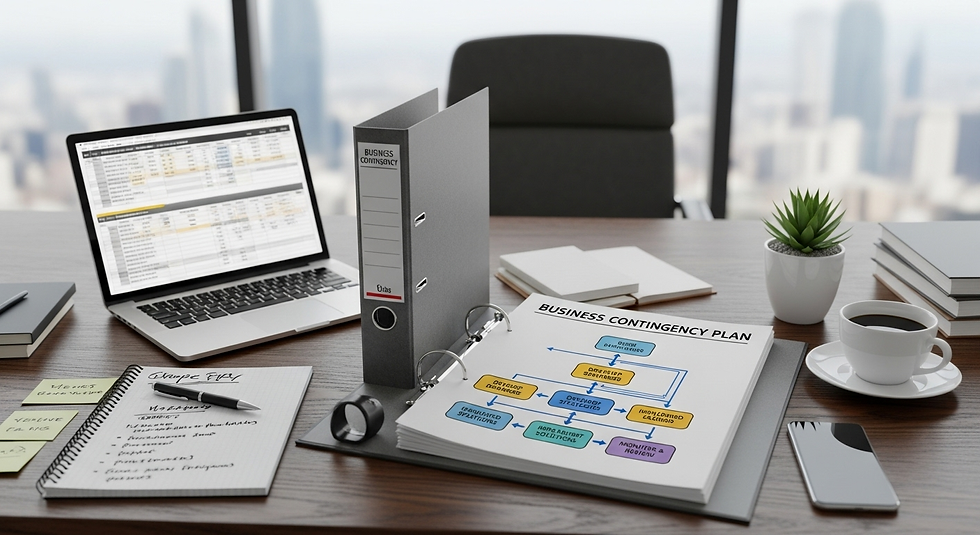Steps to Prepare a Business Continuity and Disaster Recovery Plan
- seo coder
- Aug 16, 2024
- 3 min read

Often, business people put more emphasis on growth and stability while making plans. However, one thing that they often fail to see is unforeseen disruptions, which can dismantle even the most robust plan. And that is why it is important that you have a disaster recovery and business continuity plan.
These plans are for when things go wrong, like natural disasters, fires, or cyber-attacks. A disaster recovery plan and a business continuity plan are closely interlinked. Staying operational, even in the worst-case scenario, has become important for businesses.
Here is why planning for the worst could be your greatest asset.
What's the difference between a DRP and a BCP?
While the key aim of Disaster Recovery Plans and Business Continuity Plans is to safeguard businesses from disruptions, they focus on different aspects of recovery and continuity.
A disaster recovery plan is a broad part of the business continuity strategy. It focuses primarily on restoring IT infrastructure, systems, and data after a disaster strikes. It outlines the key steps to bring IT operations back online in case of
Cyberattacks
Hardware failure
Natural disaster
It includes data backup procedures, enabling emergency power delivery, and putting strategies in place that quickly restore vital technologies to minimize downtime.
A Business Continuity Plan (BCP) is a strategy that helps a business keep operating during and after a crisis. It includes a different range of aspects, such as employee safety, communication plans, and operations processes. The BCP ensures the continuity of all essential functions in the case of a disruption to IT systems and encompasses more than just technology. The primary objective here is to ensure the smooth running of the entire business and not just the recovery of IT systems.
How to Implement Disaster Recovery Plans and Business Continuity?
There are multiple steps to follow when developing BCP and BCP. Here is what you can do to minimize the likelihood of the threat that poses risks to the continuity of your business.
Identify the Weak Points
Every business is unique, and developing a universal risk assessment of potential weak points can be challenging. However, there are specific categories that will help you guide through.
Workspace and Physical Infrastructure: This covers everything in your office space that could be affected by an event, from the building and its systems to the equipment inside.
Employees and Operations: Your team is a vital part of your business, and you should be aware of any threat that could risk their ability to work. The main concern is to avoid the shortage of staff.
Data and Applications: Your company's digital assets can be vulnerable, so protecting them from any kind of cyber attack or system failure should be the top priority.
External Partnerships and Suppliers: Most businesses rely on other companies or partners to provide services and goods, so any event could significantly disrupt business continuity.
Determine The Critical Assets
The next step is to identify the critical assets. You need to know the essential system that will keep the business running while preparing the BCP and DRP. This means you should list the assets and categorize them based on their importance. The next step is to perform the risk assessment and establish procedures to protect the potential threats.
Discern Threats: There are some solutions that help your business protect itself from common threats like fire and theft. However, there are threats that may be unique to your business. For example, a disruption in the supply chain may affect the restaurant or a cyber attack could hamper the operation of an IT company. However, the most common threats in business can be divided into two broad categories: Internal threats and external threats.
Internal Threats: These threats include things like computer hardware, software failures, theft, human errors, or document destruction.
External Threats: These include problems like natural disasters, power outages, service interruption, and cyber attacks.
Test SOPs: After you have protected your business from threats, the next step is to test your SOPs. Simulation of the problem areas that could affect your business and then applying the relevant procedures can reveal other issues that could hamper the business. If you use cloud servers for your data, a power cut could cause problems. Make sure your staff knows what to do in a disaster. Your business continuity team should assess risks and prepare your staff for emergencies.
The aim here is to avoid any event that could disrupt business, as it may be more expensive to recover from the aftermath than to prepare for it.
Conclusion:
No one likes to think of an event where a company could suffer, which is beyond their control. That is why it is essential to have business continuity and disaster recovery in place. A business continuity plan helps to prepare for the worst and achieve the business goals. A disaster recovery plan helps to restore operations after a disaster.




Comments